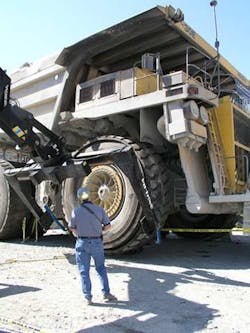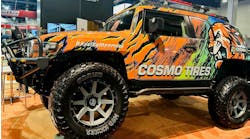Edward Lorenz was a noted mathematician and meteorologist who pioneered the study of chaos theory. He determined that when complex systems were entirely dependent on initial conditions, such as the weather, even the smallest changes could yield dramatically different results in the end. His work has been used in the fields of physics, applied mathematics, economics, biology, psychology and meteorology, to name a few. But Lorenz is probably most famous for a paper he entitled, “Does the flap of a butterfly’s wings in Brazil set off a tornado in Texas?”
One only needs to look at recent weather patterns that have been attributed to global warming to witness the genius behind his work. When the initial conditions in a complex system are extremely sensitive, even the slightest shift will totally change the outcome.
Besides academics and other more intellectual pursuits, chaos theory can also be used to analyze the OTR tire industry. Unlike the passenger, light truck and medium truck tire markets where there are only a few applications and the products have almost reached the commodity stage, OTR tires remain highly specialized. The engineering behind these complex tires continues to evolve, and while there is tremendous competition in other aspects of the tire industry, the OTR segment is relegated to only a handful of manufacturers with the resources to build the largest tires on the planet.
In order to better understand the relationship between supply and demand for OTR tires, the market must first be divided into three categories: small, large and giant.
Market segments
Small OTR tires are typically defined as those with 24- or 25-inch bead diameters that are primarily used on construction equipment such as small rubber-tire loaders and scrapers. When compared to the other segments in the OTR industry, there are definitely a lot more domestic and foreign manufacturers, so the likelihood of prolonged shortages is relatively small.
The large OTR tire market is primarily dedicated to quarry operations and mainly consists of tires with bead diameters that range from 33 inches to 49 inches. As the tire sizes get larger, the number of manufacturers gets smaller, so they are more susceptible to supply issues.
[PAGEBREAK]
Finally, the giant OTR tire segment is comprised of tires with bead diameters of 51 to 63 inches that are used in large mines. And as history has shown, the balance between supply and demand for these tires is extremely delicate for a number of reasons that will be explained later.
Unlike the passenger, light truck and medium truck tire industries, the OTR tire market can easily be described as chaotic. Most of the passenger and light truck tires used in North America are produced in North America with little reliance on overseas production. And since most of that production stays on this continent, changes offshore typically do not have a major impact on our supply because those markets have their own manufacturing plants.
Likewise, the demand for passenger and light truck tires overseas is primarily supplied by production closer to those regions, so changes in North America have little effect on their supply. The same can be said for the medium truck tire industry, although the current truck tire casing shortage can be attributed in some part to the reduction in casing imports.
On the other hand, the OTR tire industry in North America is global in every sense of the word, so it is extremely dependent on the markets abroad.
There are a number of initial conditions that affect the worldwide supply for all types of OTR tires, regardless of size. First and foremost is the demand at the original equipment level. In order to illustrate this relationship, dealer statistics from Caterpillar (the world’s largest heavy equipment manufacturer) for the past four years show how shifts in one part of the world can impact the global market.
For example, in 2007 the collective markets outside North America were up by as much as 32% in March and November. But the reduced demand on this continent brought the worldwide sales increases down to 6% and 9% for the same months.
The beginning of 2008 shows the same trend, where increased sales throughout the rest of the world were offset by decreases in North America. And by the time that the recession had a stranglehold on the global economy at the end of year, worldwide sales were down by 15% in December.
Everyone would like to forget 2009, and the dealer statistics from Caterpillar clearly demonstrate the economic downturn in every market. That trend more or less continued into the first half of 2010 until May, when the numbers started turning around. It’s also interesting to note that when North American sales experienced their first increase in more than three years, the decreases in Europe, Africa, the Middle East and Latin America were offset to actually increase the worldwide statistics. By the time November rolled around, the global market for heavy equipment had turned around faster than anyone could have forecasted.
Based on these figures, it’s fair to say that the market for new heavy equipment in North America represents another initial condition that contributes to the chaos.
In the next CTD section coming in April, we will continue our look at OTR market conditions and tire production. ■
(To see the 2007 - 2010 charts on Dealer reported retail statistics -- machines, click here.)
Kevin Rohlwing is senior vice president of training for the Tire Industry Association (e-mail [email protected]).




